Apple-like Shape of Freezing Paraffin Wax Droplets and Its Origin
Abstract
:1. Introduction
2. Materials and Methods
2.1. Materials
2.2. Experimental Procedure
3. Results
In Situ Study of the Shape of Heated and Cooled Paraffin Wax Droplets
4. Discussion
4.1. Qualitative Analysis
4.2. A Model of Cooling and Solidification of a Paraffin Wax Droplet
5. Conclusions
Supplementary Materials
Author Contributions
Funding
Institutional Review Board Statement
Informed Consent Statement
Data Availability Statement
Acknowledgments
Conflicts of Interest
References
- Sommerfeld, R.A.; LaChapelle, E. The Classification of Snow Metamorphism. J. Glaciol. 1970, 9, 3–18. [Google Scholar] [CrossRef] [Green Version]
- LaChapelle, E.R. Field Guide to Snow Crystals; University of Washington Press: Seattle, WA, USA, 1969. [Google Scholar]
- Snoeijer, J.H.; Brunet, P. Pointy ice-drops: How water freezes into a singular shape. Am. J. Phys. 2012, 80, 764–771. [Google Scholar] [CrossRef]
- Marín, A.G.; Enríquez, O.R.; Brunet, P.; Colinet, P.; Snoeijer, J.H. Universality of tip singularity formation in freezing water drops. Phys. Rev. Lett. 2014, 113, 054301. [Google Scholar] [CrossRef] [PubMed] [Green Version]
- Schetnikov, A.; Matiunin, V.; Chernov, V. Conical shape of frozen water droplets. Am. J. Phys. 2015, 83, 36–38. [Google Scholar] [CrossRef]
- Ismail, M.F.; Waghmare, P.R. Universality in freezing of an asymmetric drop. Appl. Phys. Lett. 2016, 109, 234105. [Google Scholar] [CrossRef]
- Kolasinski, K.W. Solid structure formation during the liquid/solid phase transition. Curr. Opin. Solid State Mater. Sci. 2007, 11, 76–85. [Google Scholar] [CrossRef]
- Starostin, A.; Strelnikov, V.; Dombrovsky, L.A.; Shoval, S.; Bormashenko, E. On the universality of shapes of the freezing water droplets. Colloids Interface Sci. Comm. 2022, 47, 100590. [Google Scholar] [CrossRef]
- Starostin, A.; Strelnikov, V.; Dombrovsky, L.A.; Shoval, S.; Gendelman, O.; Bormashenko, E. Effect of asymmetric cooling of sessile droplets on orientation of the freezing tip. J. Colloid Interface Sci. 2022, 620, 179–186. [Google Scholar] [CrossRef]
- Gandee, H.; Zhou, Y.; Lee, J.; Chomali, J.; Xu, H.; Adera, S. Unique ice dendrite morphology on state-of-the-art oil-impregnated surfaces. Proc. Natl. Acad. Sci. USA 2023, 120, e2214143120. [Google Scholar] [CrossRef]
- Li, R.; Ashgriz, N.; Chandra, S.; Andrews, J.R.; Williams, J. Drawback during deposition of overlapping molten wax droplets. J. Manuf. Sci. Eng. 2008, 130, 041011. [Google Scholar] [CrossRef]
- Gao, F.; Sonin, A.A. Precise Deposition of Molten Microdrops: The Physics of Digital Microfabrication. Proc. R. Soc. Lond. Ser. A 1994, 444, 533–554. [Google Scholar] [CrossRef]
- Shang, Y.; Liu, X.; Bai, B.; Zhong, X. Central-pointy to central-concave icing transition of an impact droplet by increasing surface subcooling. Int. J. Heat Mass Transf. 2019, 108, 104326. [Google Scholar] [CrossRef]
- Hu, M.; Wang, F.; Tao, Q.; Chen, L.; Rubinstein, S.M.; Deng, D. Frozen patterns of impacted droplets: From conical tips to toroidal shapes. Phys. Rev. Fluids 2020, 5, 081601. [Google Scholar] [CrossRef]
- Ma, Z.; Xiong, W.; Cheng, P. 3D Lattice Boltzmann simulations for water droplet’s impact and transition from central-pointy icing pattern to central-concave icing pattern on supercooled surfaces. Part I: Smooth surfaces. Int. J. Heat Mass Transf. 2021, 171, 121097. [Google Scholar] [CrossRef]
- Fang, W.-Z.; Zhu, F.; Tao, W.-Q.; Yang, C. How different freezing morphologies of impacting droplets form. J. Colloid Interface Sci. 2021, 584, 403–410. [Google Scholar] [CrossRef] [PubMed]
- Oldenburg, D.W.; Brune, J.N. Ridge transform fault spreading pattern in freezing wax. Science 1972, 178, 301–304. [Google Scholar] [CrossRef]
- Xie, A.-X.; Rendine, N.; Ji, H.-F. Anisotropic and Isotropic Shrinking of Candle Droplets in Cold Water and Warm Water. Micro 2022, 2, 508–512. [Google Scholar] [CrossRef]
- Himran, S.; Suwono, A.; Mansoori, A. Characterization of alkanes and paraffin waxes for application as phase change energy storage medium. Energy Sources 1994, 16, 117–128. [Google Scholar] [CrossRef]
- Akgün, M.; Aydın, O.; Kaygusuz, K. Experimental study on melting/solidification characteristics of a paraffin as PCM. Energy Convers. Manag. 2007, 48, 669–678. [Google Scholar] [CrossRef]
- Akgün, M.; Aydın, O.; Kaygusuz, K. Thermal energy storage performance of paraffin in a novel tube-in-shell system. Appl. Therm. Eng. 2008, 28, 405–413. [Google Scholar] [CrossRef]
- Vakhshouri, A.R. Paraffin as phase change material. In Paraffin—An Overview; Soliman, F.S., Ed.; IntechOpen: London, UK, 2020. [Google Scholar] [CrossRef]
- Mishra, D.K.; Bhowmik, C.; Bhowmik, S.; Pandey, K.M. Property-enhanced paraffin-based composite phase change material for thermal energy storage: A review. Environ. Sci. Pollut. Res. 2022, 29, 43556–43587. [Google Scholar] [CrossRef] [PubMed]
- Terekhov, V.I.; Kalinina, S.V.; Mshvidobadze, Y.M. Heat Transfer Coefficient and Aerodynamic Resistance on a Surface with a Single Dimple. J. Enhanc. Heat Transf. 1997, 4, 131–145. [Google Scholar] [CrossRef]
- Terekhov, V.I.; Kalinina, S.V.; Mshvidobadze, Y.M. A review on heat trasnsfer coefficient and aerodynamic resistance on a surface with a single dimple. J. Enhanc. Heat Transf. 2017, 24, 549–568. [Google Scholar] [CrossRef]
- Choi, S.M.; Kwon, H.G.; Kim, T.; Moon, H.K.; Cho, H.H. Active cooling of photovoltaic (PV) cell by acoustic excitation in single-dimpled internal channel. Appl. Energy 2022, 309, 118466. [Google Scholar] [CrossRef]
- Shchukin, A.V.; Kozlov, A.P.; Chudnovsky, Y.P.; Agachev, R.S. Intensification of Heat Exchange by Spherical Depressions: A Survey. Appl. Energy 1998, 36, 45–62. [Google Scholar]
- Syred, N.; Khalatov, A.; Kozlov, A.; Shchukin, A.; Agachev, R. Effect of surface curvature on heat transfer and hydrodynamics within a single hemispherical dimple. J. Turbomach. 2001, 123, 609–613. [Google Scholar] [CrossRef]
- Lubarda, V.A.; Talke, K.A. Analysis of the equilibrium droplet shape based on an ellipsoidal droplet model. Langmuir 2011, 27, 10705–10713. [Google Scholar] [CrossRef]
- Whyman, G.; Bormashenko, E.d. Oblate spheroid model for calculation of the shape and contact angles of heavy droplets. J. Colloid Interface Sci. 2009, 331, 174–177. [Google Scholar] [CrossRef]
- Xia, Y.; Whitesides, G.M. Soft lithography. Angew. Chem. 1998, 37, 550–575. [Google Scholar] [CrossRef]
- Jasper, J.J. The surface tension of pure liquid compounds. J. Phys. Chem. Ref. Data 1972, 1, 841. [Google Scholar] [CrossRef] [Green Version]
- Rossetti, F.; Ranalli, G.; Faccenna, C. Rheological properties of paraffin as an analogue material for viscous crustal deformation. J. Struct. Geol. 1999, 21, 413–417. [Google Scholar] [CrossRef]
- Starostin, A.; Strelnikov, V.; Dombrovsky, L.A.; Shoval, S.; Bormashenko, E. Three scenarios of freezing of liquid marbles. Colloids Surf. A 2022, 636, 128125. [Google Scholar] [CrossRef]
- Ferrer, G.; Gschwander, S.; Solé, A.; Barreneche, C.; Fernández, A.I.; Schossig, P.; Cabeza, L.F. Empirical equation to estimate viscosity of paraffin. J. Energy Storage 2017, 11, 154–161. [Google Scholar] [CrossRef] [Green Version]
- Dombrovsky, L.A.; Nenarokomova, N.B.; Tsiganov, D.I.; Zeigarnik, Y.A. Modeling of repeating freezing of biological tissues and analysis of possible microwave monitoring of volumetric phase changes. Int. J. Heat Mass Transf. 2015, 89, 894–902. [Google Scholar] [CrossRef]
- Dombrovsky, L.A.; Kokhanovsky, A.A.; Randrianalisoa, J.H. On snowpack heating by solar radiation: A computational model. J. Quant. Spectrosc. Radiat. Transf. 2019, 227, 72–85. [Google Scholar] [CrossRef]
- Starostin, A.; Strelnikov, V.; Dombrovsky, L.A.; Shoval, S.; Gendelman, O.; Bormashenko, E. Effects of asymmetric cooling and surface wettability on the orientation of the freezing tip. Surf. Innov. 2023; ahead of print. [Google Scholar] [CrossRef]
- Kumar, M.; Krishna, D.J. Influence of mushy zone constant on thermohydraulics of PCM. Energy Procedia 2017, 109, 314–321. [Google Scholar] [CrossRef]
- Fadl, M.; Eams, P.C. Numerical investigation of the influence of mushy zone parameter Amush on heat transfer characteristics in vertically and horizontally oriented thermal energy storage systems. Appl. Therm. Eng. 2019, 151, 90–99. [Google Scholar] [CrossRef]
- Soliman, A.S.; Sultan, A.A.; Sultan, M.A. Effect of mushy zone parameter on phase change behavior of different configurations storage unit: Numerical simulation and experimental validation. Sustainability 2022, 14, 14540. [Google Scholar] [CrossRef]
- Fedorets, A.A.; Dombrovsky, L.A. Generation of levitating droplet clusters above the locally heated water surface: A thermal analysis of modified installation. Int. J. Heat Mass Transf. 2017, 104, 1268–1274. [Google Scholar] [CrossRef]
- Frenkel, M.; Dombrovsky, L.A.; Multanen, V.; Danchuk, V.; Legchenkova, I.; Shoval, S.; Bormashenko, Y.; Binks, B.P.; Bormashenko, E. Self-propulsion of water-supported liquid marbles filled with sulfuric acid. J. Phys. Chem. B 2018, 122, 7936–7942. [Google Scholar] [CrossRef]
- Farid, M.M.; Khudhair, A.M.; Razack, S.A.K.; Al-Hallaj, S. A review on phase change energy storage: Materials and applications. Energy Convers. Manag. 2004, 45, 1597–1615. [Google Scholar] [CrossRef]
- Aguenim, F.; Hewitt, N.; Eams, P.; Smyth, M. A review of materials, heat transfer and phase change problem formulation for latent heat thermal energy storage systems (LHTESS). Renew. Sustain. Energy Rev. 2010, 14, 615–628. [Google Scholar] [CrossRef]
- Grigor’ev, I.S.; Dedov, A.V.; Eletskii, A.V. Phase change materials and power engineering. Therm. Eng. 2021, 68, 257–269. [Google Scholar] [CrossRef]
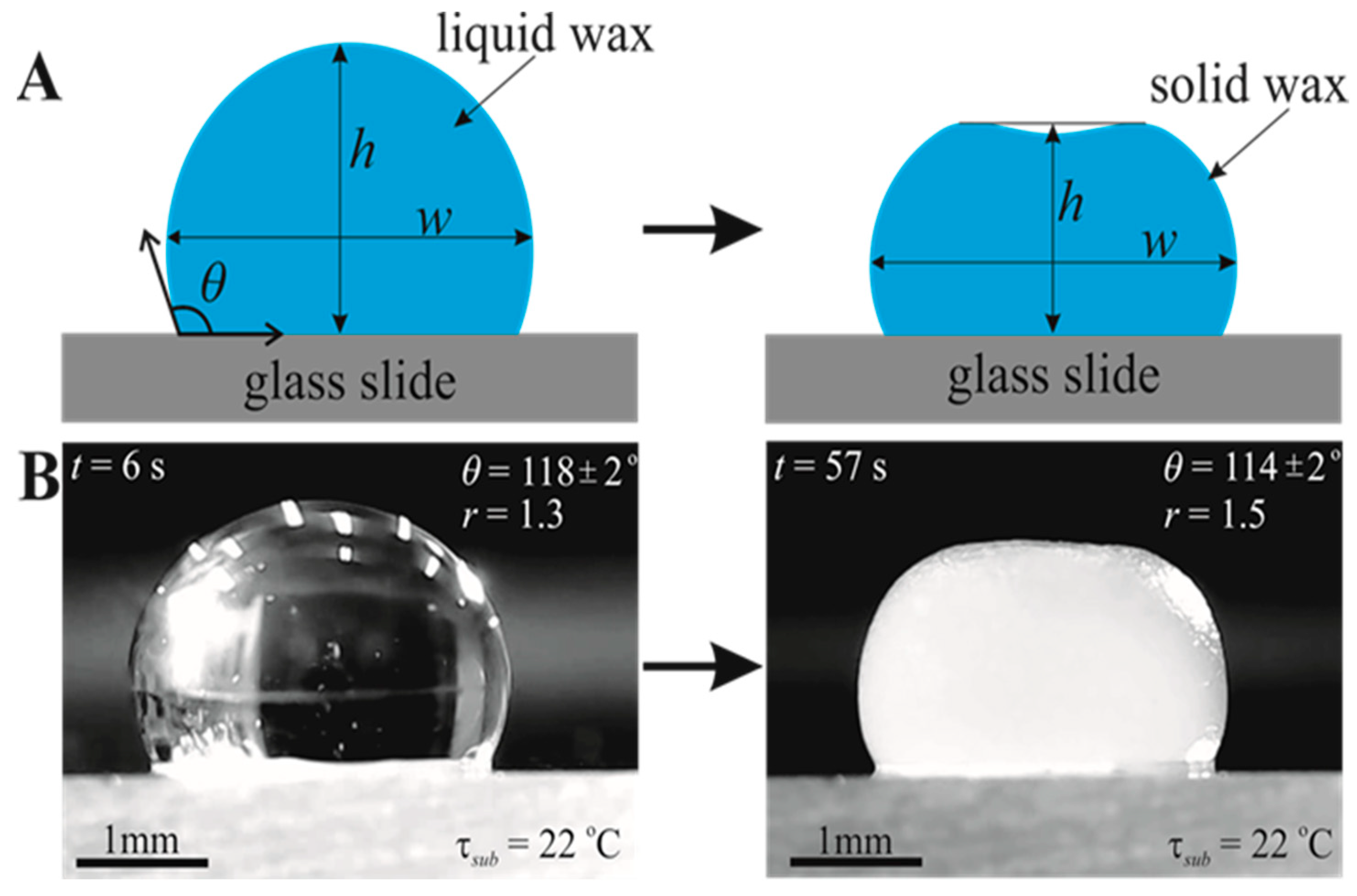
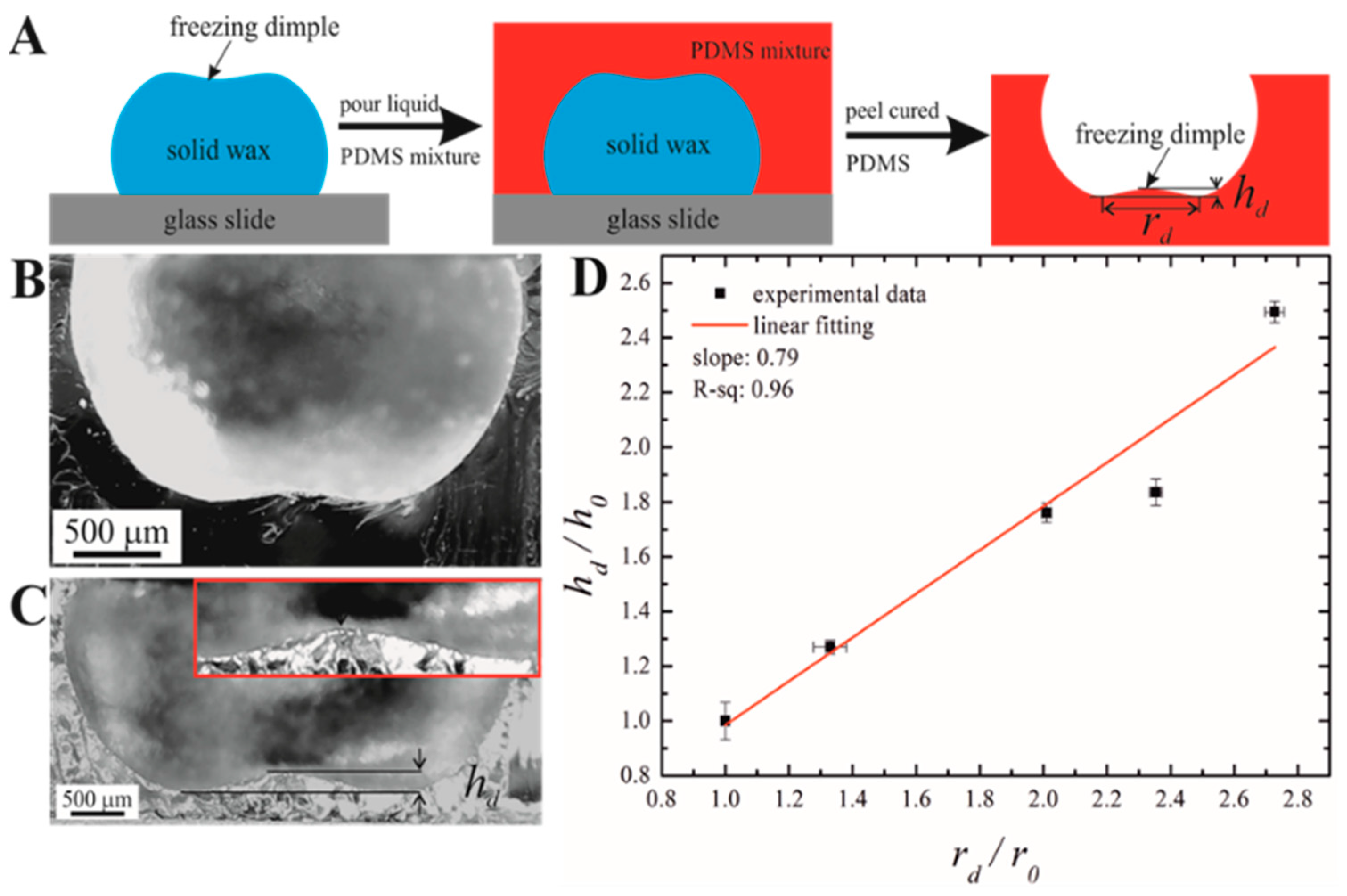
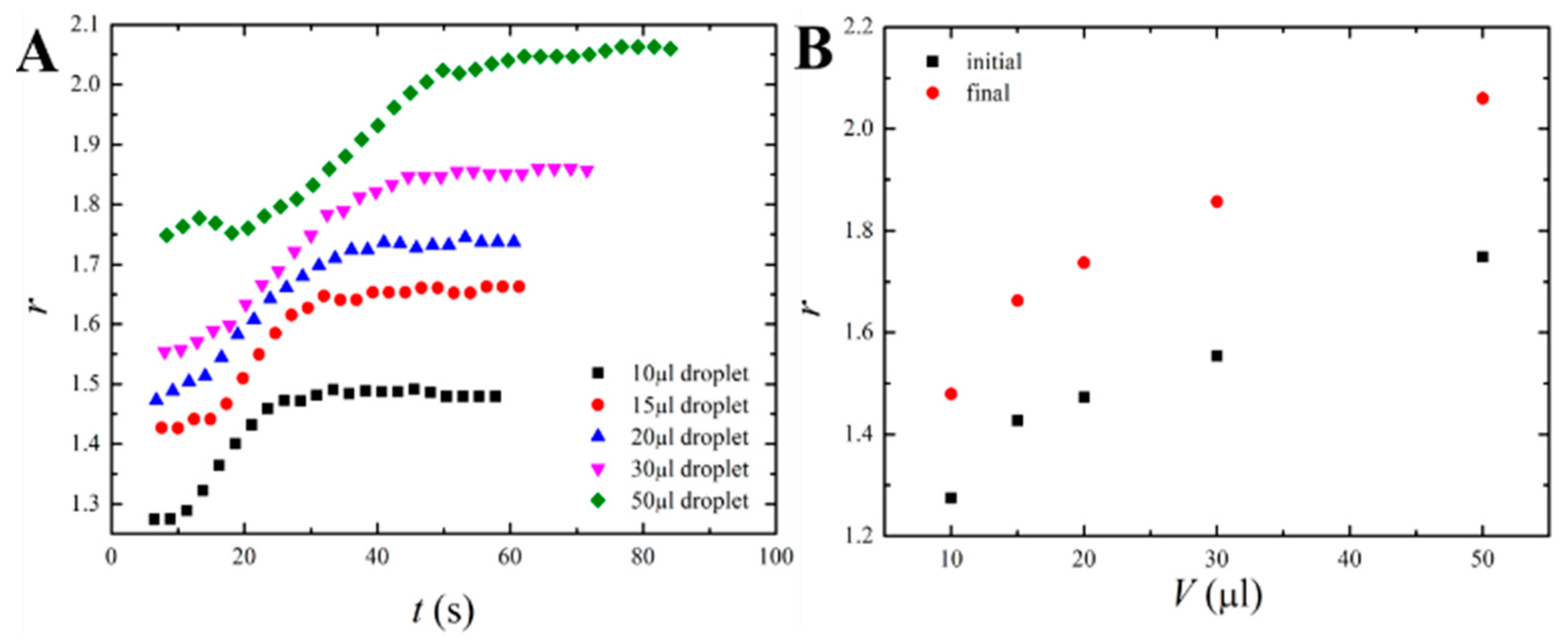

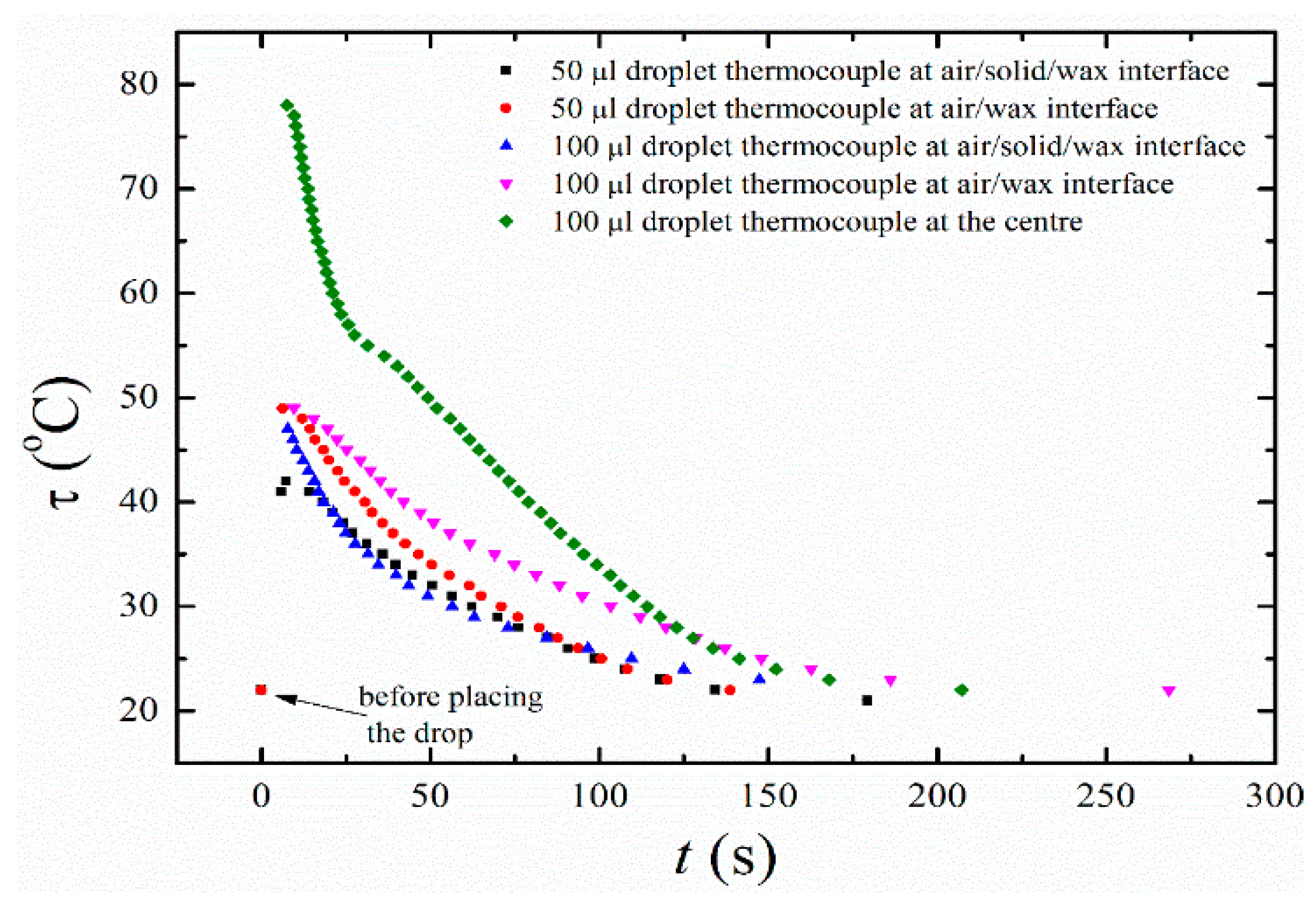
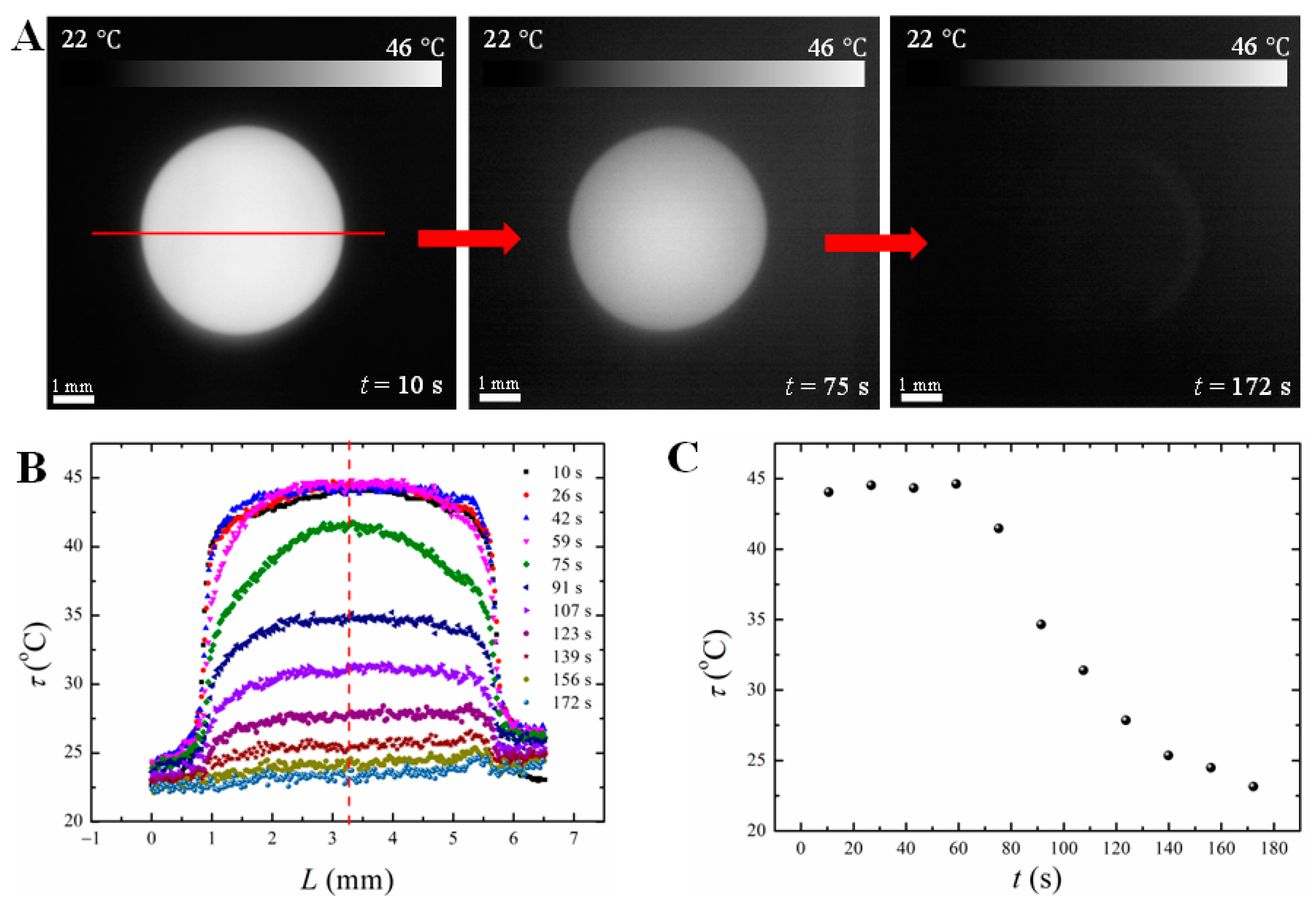
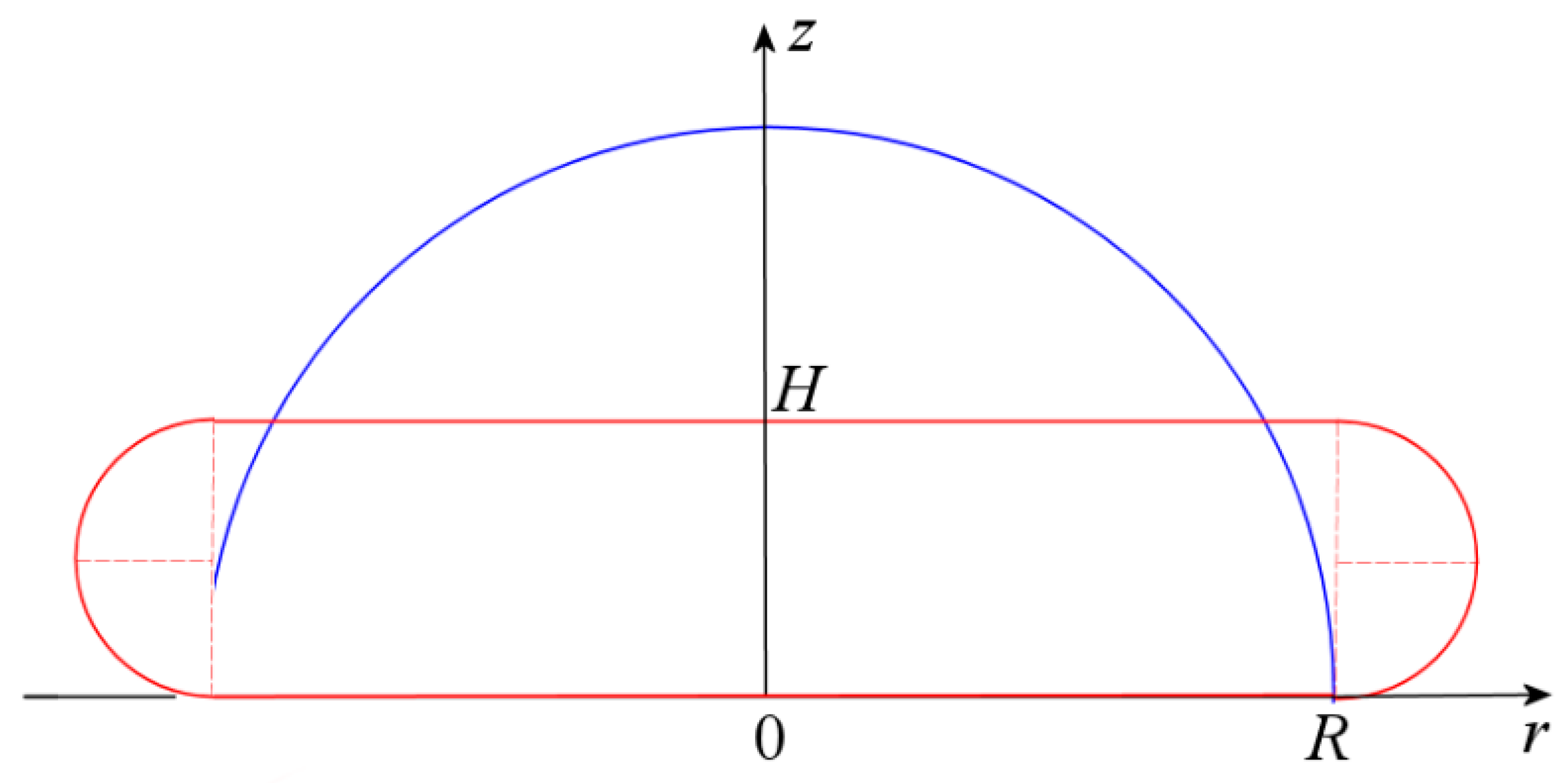
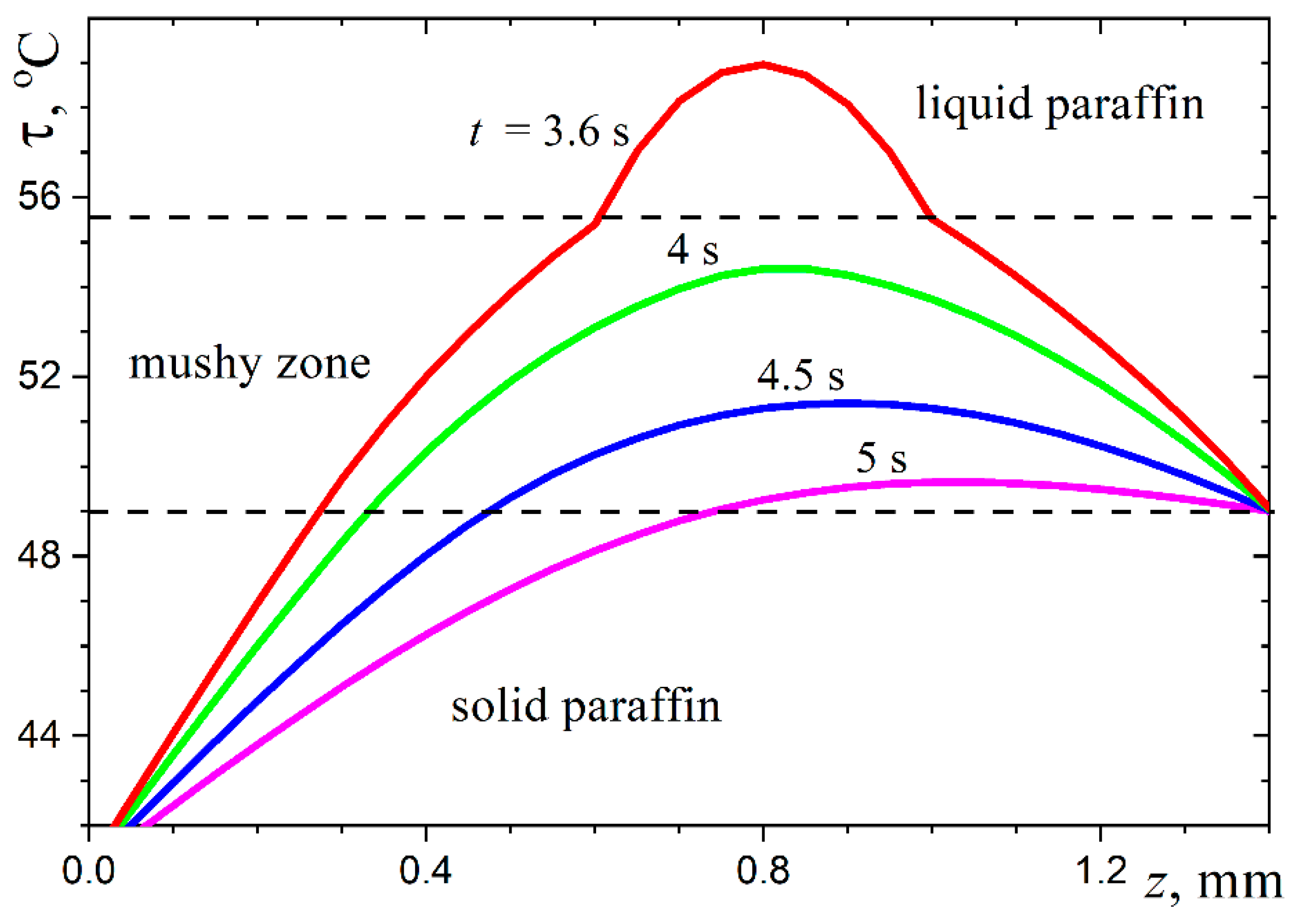
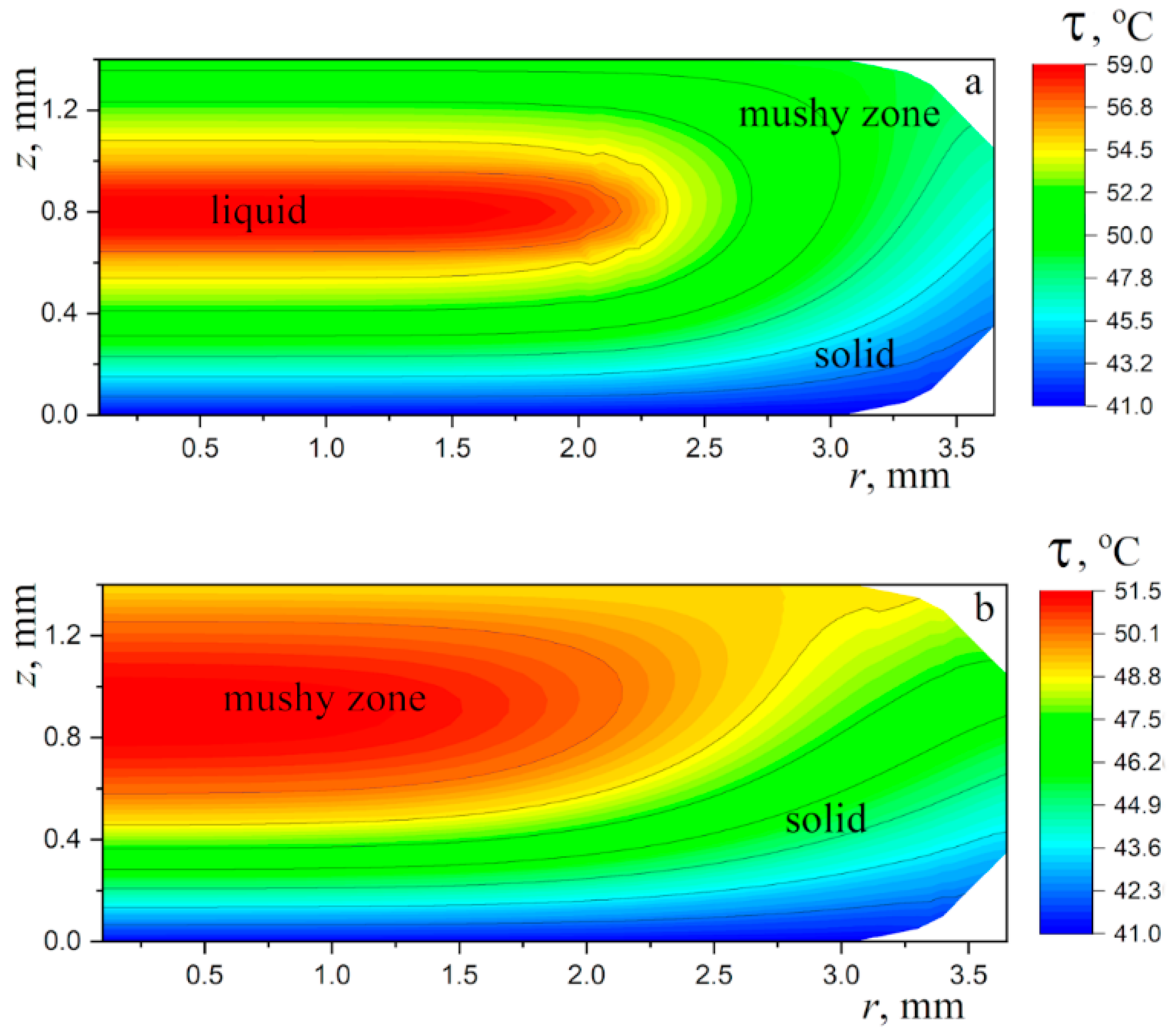
Disclaimer/Publisher’s Note: The statements, opinions and data contained in all publications are solely those of the individual author(s) and contributor(s) and not of MDPI and/or the editor(s). MDPI and/or the editor(s) disclaim responsibility for any injury to people or property resulting from any ideas, methods, instructions or products referred to in the content. |
© 2023 by the authors. Licensee MDPI, Basel, Switzerland. This article is an open access article distributed under the terms and conditions of the Creative Commons Attribution (CC BY) license (https://creativecommons.org/licenses/by/4.0/).
Share and Cite
Roy, P.K.; Shoval, S.; Shvalb, N.; Dombrovsky, L.A.; Gendelman, O.; Bormashenko, E. Apple-like Shape of Freezing Paraffin Wax Droplets and Its Origin. Materials 2023, 16, 5514. https://doi.org/10.3390/ma16165514
Roy PK, Shoval S, Shvalb N, Dombrovsky LA, Gendelman O, Bormashenko E. Apple-like Shape of Freezing Paraffin Wax Droplets and Its Origin. Materials. 2023; 16(16):5514. https://doi.org/10.3390/ma16165514
Chicago/Turabian StyleRoy, Pritam Kumar, Shraga Shoval, Nir Shvalb, Leonid A. Dombrovsky, Oleg Gendelman, and Edward Bormashenko. 2023. "Apple-like Shape of Freezing Paraffin Wax Droplets and Its Origin" Materials 16, no. 16: 5514. https://doi.org/10.3390/ma16165514
APA StyleRoy, P. K., Shoval, S., Shvalb, N., Dombrovsky, L. A., Gendelman, O., & Bormashenko, E. (2023). Apple-like Shape of Freezing Paraffin Wax Droplets and Its Origin. Materials, 16(16), 5514. https://doi.org/10.3390/ma16165514









